You searched for: 外贸谷歌竞价【TG飞机:@bapingseo】北京赛车1390x【TG电报:@bapingseo】廣東谷歌推廣產品哪家強【Telegram:@bapingseo】梦之城网站王者荣耀下注官网亚博网址版足猜彩怎样可以做到稳定盈利?7BtkWY/266272.html
<< Previous | Displaying results 76-100 of 280 for "外贸谷歌竞价【TG飞机:@bapingseo】北京赛车1390x【TG电报:@bapingseo】廣東谷歌推廣產品哪家強【Telegram:@bapingseo】梦之城网站王者荣耀下注官网亚博网址版足猜彩怎样可以做到稳定盈利?7BtkWY/266272.html" | Next >>
-
Pacific Theater
Media EssayOn December 7, 1941, Japan launched an attack on the American navel base at Pearl Harbor. The following day, the United States declared war on Japan, entering into World War II. World War II in the Pacific ended when Japan surrendered on Sep...
-
Pants belonging to Marjan Glass
ArtifactPants worn by Marjan Glass as he dug anti-tank ditches for the defense of Warsaw, Poland, and then as he hastily fled the city ahead of the German advance on September 7, 1939. Glass, a lawyer, escaped with his wife and three-year-old son, and his wife's mother and brother. He left without taking the time to change from his soiled work clothing. [From the USHMM special exhibition Flight and Rescue.]

-
Victory in Europe!
FilmGermany's formal surrender on May 7 and VE-Day (Victory in Europe Day) on May 8, 1945, were marked by joyous celebrations all over Europe. This footage shows streets in Paris and London filled with people celebrating the unconditional Allied victory over Nazi Germany and the winning of the war in Europe.
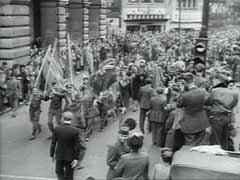
-
Irmgard Huber, chief nurse at Hadamar euthanasia killing center
PhotoPortrait of Irmgard Huber, chief nurse at the Hadamar euthanasia killing center, in her office. The photograph was taken by an American military photographer on April 7, 1945.

-
8th Infantry troops approach a town in Belgium
PhotoUS soldiers of the 8th Infantry Regiment seek cover behind hedges and signs to return fire to German forces holding the town of Libin. Belgium, September 7, 1944.
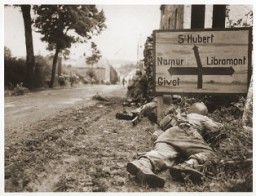
-
Burying the victims of Wöbbelin
PhotoAfter the liberation of the Wöbbelin camp, US troops forced the townspeople of Ludwigslust to bury the bodies of prisoners killed in the camp. This photograph shows German civilians who were ordered to bury the dead; US troops stand in the background. Germany, May 7, 1945

-
Captured German soldiers remove bodies from a barracks in Gunskirchen
PhotoMedical corpsmen of the US 71st Infantry Division, 3rd US Army look on as captured German soldiers remove bodies from inside a barracks in Gunskirchen. In the foreground, a Jewish girl lies huddled in the straw on the floor of the barracks. Gunskirchen, Austria, May 7, 1945.
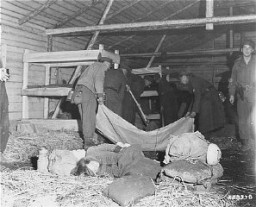
-
Hannah Szenes
PhotoHannah Szenes on her first day in Palestine. Haifa, Palestine, September 19, 1939. Between 1943 and 1945, a group of Jewish men and women from Palestine who had volunteered to join the British army parachuted into German-occupied Europe. Their mission was to organize resistance to the Germans and aid in the rescue of Allied personnel. Hannah Szenes was among these volunteers. Szenes was captured in German-occupied Hungary and executed in Budapest on November 7, 1944, at the age of 23.
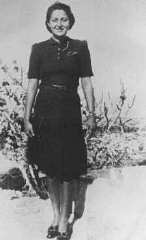
-
Elisabeth, Hans Werner, and Paul Gerhard Kusserow
PhotoElisabeth, Hans Werner, and Paul Gerhard Kusserow. Because they were the children of Jehovah's Witnesses, all three were forcibly removed from school on March 7, 1939, and kept separated from their family, which was accused of spiritual and moral neglect, until their liberation in April 1945. This photograph was taken at the Kusserow home in Bad Lippspringe, 1936-1939.
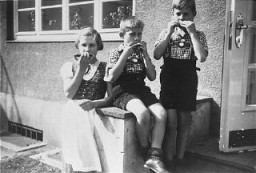
-
Liberated Soviet and Polish prisoners at Mauthausen
PhotoSoviet and Polish prisoners with disabilities stand in front of a tank of the 11th Armored Division, US Third Army. This photograph was taken at the Mauthausen concentration camp immediately after liberation. Austria, May 5–7, 1945.
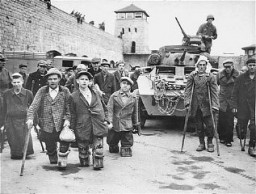
-
Anonymous Girl Diarist from the Lodz Ghetto
ArticleDiaries bear witness to some of the most heartbreaking experiences of the Holocaust. Read excerpts from the diary of an anonymous child in the Lodz ghetto.
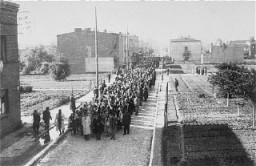
-
Tunisia Campaign
ArticleLearn more about the 1943 Tunisia campaign, a four-month long struggle between Allied and Axis powers in North Africa during World War II.
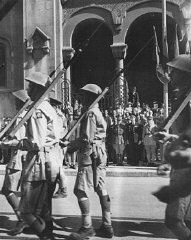
-
World War II in Eastern Europe, 1942–1945
ArticleBefore 1942, Nazi Germany had expanded across much of Europe. Learn more about major Allied victories in eastern Europe that led to the German surrender.
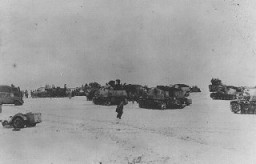
-
Fire Oaths
Article“Fire Oaths” were statements that declared why the works of certain authors were thrown into the flames during the 1933 burning of books under the Nazi regime.

-
The Rhine Crossings in World War II
ArticleCrossing the Rhine River allowed US and British troops to advance into the interior of Germany, helping to bring about the defeat of the Third Reich in WWII
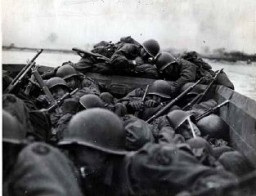
-
Jewish Uprisings in Camps
ArticleLearn more about Jewish prisoners and the various uprisings and armed resistance movements in killing centers and other Nazi camps.

-
Deggendorf Displaced Persons Camp
ArticleAfter WWII, many Holocaust survivors, unable to return to their homes, lived in displaced persons camps in Germany, Austria, and Italy. Read about Deggendorf DP camp.

-
Rescue and Resistance
SeriesBrowse a series of articles describing how some Jews survived the Holocaust; rescue efforts; anti-Nazi resistance groups; and revolts against Nazi oppression in the Warsaw ghetto and in killing centers.
-
Polish Jews in Lithuania: Escape to Japan
ArticleAfter 1940, Polish refugees were pressured to leave Lithuania. Learn more about the diplomats that assisted them and their journey to Japan.
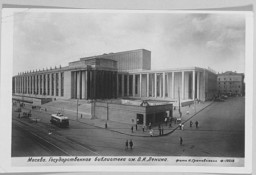
-
Claude Brunswic
ID CardClaude was one of five children born to Jewish parents in the university city of Heidelberg. His father, a physician specializing in internal medicine, had his practice on the first floor of the apartment building in which the family lived. Claude was an avid swimmer until November 1932, when local Nazi party edicts forbad Jews to use the city pool where he swam. 1933-39: In January 1933, just after Hitler became chancellor of Germany, hoodlums attacked Jewish-owned businesses in Heidelberg. They broke…
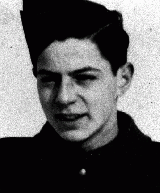
-
Jozef Rapaport
ID CardJozef was raised in a religious Jewish family. When he was a baby, his father died and his mother was left to care for him and his three older sisters. The family was poor, but Jozef was determined to have a good education. He put himself through university in Prague, and then went on to earn a Ph.D. in economics in Vienna. In 1931 he married Leah Kohl, and the couple settled in Warsaw. 1933-39: The Rapaports lived in the suburbs, and Jozef worked as a banker. His daughter, Zofia, was born in 1933. Jozef…
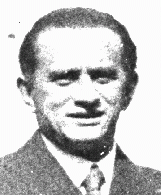
-
Renate Guttmann
ID CardRenate, her twin brother, Rene, and their German-Jewish parents lived in Prague. Shortly before the twins were born, Renate's parents had fled Dresden, Germany, to escape the Nazi government's policies against Jews. Before leaving Germany to live in Czechoslovakia, Renate's father, Herbert, worked in the import-export business. Her mother, Ita, was an accountant. 1933-39: Renate's family lived in a six-story apartment building along the #22 trolley line in Prague. A long, steep flight of stairs led up to…
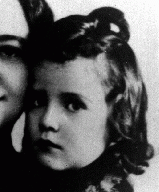
-
Rene Guttmann
ID CardRene, his twin sister, Renate, and their German-Jewish parents lived in Prague. Shortly before the twins were born, Rene's parents had fled Dresden, Germany, to escape the Nazi government's policies against Jews. Before leaving Germany to live in Czechoslovakia, Rene's father, Herbert, had worked in the import-export business. His mother, Ita, was an accountant. 1933-39: Rene's family lived in a six-story apartment building along the #22 trolley line in Prague. A long, steep flight of stairs led up to…

-
Victims of medical experiments testify during Medical Case
FilmThe Medical Case was one of 12 war crimes trials held before an American tribunal as part of the Subsequent Nuremberg Proceedings. On trial were doctors and nurses who had participated in the killing of physically and mentally impaired Germans and who had performed medical experiments on people imprisoned in concentration camps. Here, concentration camp survivors Maria Kusmierczuk and Jadwiga Dzido, who had been victims of these experiments, show their injuries to the court as evidence.
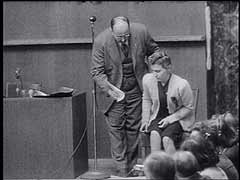
-
Rene Slotkin describes medical experiments at Auschwitz
Oral HistoryRene and his twin sister Irene were born Rene and Renate Guttman. The family moved to Prague shortly after the twins' birth, where they were living when the Germans occupied Bohemia and Moravia in March 1939. A few months later, uniformed Germans arrested their father. Decades later, Rene and Irene learned that he was killed in the Auschwitz camp in December 1941. Rene, Irene, and their thier mother were deported to the Theresienstadt ghetto, and later to Auschwitz. There, the twins were separated and…

